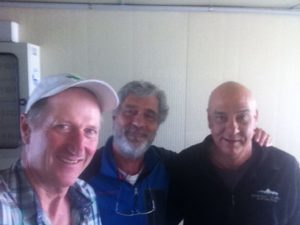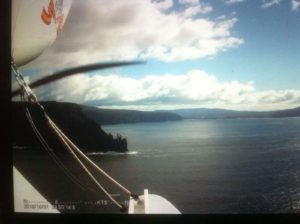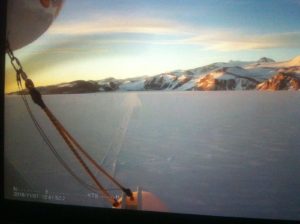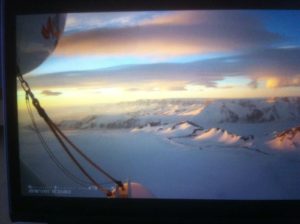Report from Mario Station
Michel has had enough time to write about his harrowing flight from Hobart to Mario Station. The internet is slow (and expensive to send messages) so we are lucky to get this report.
Tasmania is beautiful place. And also what makes it more beautiful is the people there.
The Aeroclub of Southern Tasmania (Don Prairie) and Par Aviation (Greg Wells) have been really nice with me, since the very first time I did contact them.
Joy Roa, from Asian Air Safari came into Hobart, to video report my stay there, and aircraft preparation for Antarctica.
All was ready, waiting for me: the skis, the spare aethalometer (would I need it), a spare
Spidertracks (would I need it also) and other stuff. Soon I met Paul Boland, who finally became my guardian angel, and helped me quite a lot.
My aircraft was hangared, and I was provided with anything I could need. I had the luck to share with Joy and its crew a nice visit to Bonorong Wildlife Sanctuary, where I saw the first time, many local animals, including birds, snakes, Koalas and Kangaroos.
We can say that it was an only relaxing moment since long, but soon it was over and I had to keep going with the flight.
I went through the 50 hours aircraft maintenance check and installing the skis. Everybody was there, a true aeronautical ¨church¨. Don had my aircraft so clean, that it looked brand new. The skis installation was straightforward, thanks to the designer Patrick Gilligan. Once the job was done, the aircraft looked very nice.
I am writing from Italian Polar Antarctic Station, and sharing a lot of things and experiences.
Many airplanes do arrive here, but mainly those are Twin Otters, Baslers and C130’s.
Baslers are a kind of turboprop DC3, and it is interesting to know that they don´t install the tail ski…
Mine, was installed. Didn´t know before and besides, it is so small that should not be a concern.
I had a test flight and everything was right, concerning the stability, and alignment.
But the big issue was speed: straight loss of 11 indicated kts, at somehow light weight for me. So Paul and I discussed later about that. Speed was too bad, but ditching with skis was much safer, would it necessary (the aircraft would not flip over). Also, skis allowed me to land over snow or ice, at many areas in Antarctica. As I had plenty of fuel and endurance, the decision to fly with them into Mario Zucchelli, was taken.
That way, also I would test them at heavy weights. I also tested the new steel braided HF antenna. The one I was flying was a special one, but finally was too fragile for the purpose.
I have built at Hobart two of those steel braided HF antennas, just in case one is broken. The test results were slightly worse than the former antenna, but ok. Also I was fortunate to find a ¨Marina¨ next to the Hotel. They had available a radar reflector. That
RR is a kind of plastic tube, designed to be seen by a SAR Search and Rescue) radar. So far my intentions were to use aluminum foil, for the same purpose, would I ditch somewhere.
Altogether, I kept watching a close eye into the weather. Crossing the southern sea would be not a piece of cake! The path was not clear. But aircraft have something called 3D, so that third dimension was to be studied again. After many hours of studying, there was a chance to be entering some clear ¨bubbles¨ areas that were moving fast. I was concerned about crossing two clouds barriers (clouds down there means icing, and icing means the end of the flight).
First one could be flown at low level, even 4000 ft., because temperature was higher than zero Celsius. It was to be cloudy, but not a big issue to fly in clouds. Second issue was a front I could cross when close to Antarctica, south of ¨Young Island¨. That barrier was deteriorating later but was there at my intended arrival time.
I organized everything to depart the next day at 7 AM, local time. Paul and I were too late for the dinner at Paul´s home, where her wife was waiting for us. Even at their home, before dinner and right after, we kept working (flight plan, departing Australia procedures, and plenty of other things). Also Paul´s wife got involved with the project: she installed the right Velcro on one of my survival flight suit pockets lip.
So finally, the night was very short for me, some 3,5 hours…Even though I kept thinking about the flight: what would I do if I couldn’t go through? Next morning, I checked again the weather prediction along the route. I found that flying left of my path when approaching Antarctica, could have me away of that barrier. The flight time would increase easily some 1,5 hrs, but I would be safe. That escape route was very important to me.
Also the prediction showed that two hours after reaching Young Island, the tops of that clouds barrier were going down to some 10,000ft, so I would be able to fly above them.
The decision for the flight was made and also to delay it for two hours.
If you take the time to study the flight track, you will see that it is not a direct one. I was to track south east, then turn left a little bit to cross the first barrier, and then direct to south. At 0900 local, the aircraft was refueled, I had all the survival gear ready, dry suit on, breakfast on, and hot water inside the thermos bottle, to have water available to drink during the flight ( because water freezes soon inside the plane). Also I had the time to break the rear window of Paul´s car!!!! Sorryyyyyyy Paul !
The problem was again the skis. The heavy aircraft would have the steel main landing gear opening its legs, and have the skis axles pointing downwards, so the skis internal border would touch the ground. Was that compatible with taxi and take off? The aircraft was being able to be pushed, so the skis drag was more or less ok. Then the aircraft weight was to be increase by my weight…
Once the clearance was provided by Hobart Tower and I did taxi the plane. It was draggy! I needed a lot of power to taxi it. Wind was headwinds, coming a little bit from the left, so I applied full power and soon, some lift was present in the wings, so the weight became lower, the axles positioned parallel to the ground and so the skis. Friction was gone and then the aircraft accelerated right. The take-off, seen by the Tower, would have looked standard and good. I was cleared to stay under 3500 ft., initially. So I did. Not because of the clearance, but because of the skis drag. I was unable to get past the 105 kts indicated, nor able to climb higher than 1500 ft.
The altitude was however right with my needs, and I knew that later I would have higher capability to climb and cruise faster.
Rear Center of Gravity didn´t help either. Autopilot was not able to control the airplane, so I had to fly it manually for some two hours to have the CG inside the autopilot range.
So, the rear tank was the engine feeding one, to have the sooner, the CG going forward. Then some of the external tank fuel was used to lower the level and avoid losing fuel through the vents. Then the rear tank again, the belly tank, the forward tank and back to the external wing tanks…
Everything relative to the weather was as predicted by Windity software. The clouds were at the predicted places, so the temperatures, so the thickness of the clouds, so the base layer and tops. However, when I was crossing that first front, at already 4000 ft., I was looking at the rain drops running along the windshield. Those ones started to become lazy and slowing their motion. Ice was about to form and that meant big danger. I started my descent immediately, to increase the speed and then the wind friction over the airplane (more heat). At 3000 ft., the rain drops went fast again and soon, I entered the clear bubble area, the one that would have me next to Antarctica.
Don Pearsall was tracking the flight with the Spidertracks all the time and providing my position reports to Melbourne Center. We kept chatting with SpiderTXT, and that was very nice.
Even though the flight plan was submitted and approved, Mario Zucchelli (MZS) didn´t receive it. Something rang in my head, and I asked Don if he could contact MZS to inform them about my expected arrival time. He did manage to do so, and that was good, because they were not knowing about my arrival. Australia helped again with that procedure. Talking about Australia SAR… they advised me that I would have to survive 3 to 5 days, would I ditch somewhere, before they could have their ship to rescue me….
That keep the mind quite awake!!!!
Before departing I had to confirm the light conditions during my last part of the flight and upon arrival. I was going to be a Civil twilight condition for some two hours over Antarctica, and then, sunrise again. Civil twilight provides good enough light to see and avoid, if necessary, the clouds and obstacles. Those clouds were there!!! The ones to be through.
I started a long and shallow climb and finally ended at 12000 ft., to be above those clouds. Temperature was already minus 20 C, and inside the cockpit it was nice (good idea to install a second heat muff). Underneath, the sea was already ice, broken by thousands of billions micro icebergs, together with huge ones that were impressive.
Soon, the true rocky mountains were in sight: weather was looking promising and chances were to fly direct MZS. I entered the Rennick huge glacier, and soon saw the lenticular clouds in front of me and left of my course.
That meant strong winds, and strong winds inside mountains meant high danger.
All my model aircraft slope soaring experience was to be used: I had to fly the headwind side of the slopes, or the updraft side of the downwind mountain waves, and so I did!
Even doing that, the wind was so strong that it pushed me into the slope of the Southern Cross mountains, at such a speed that I had to use some 30 or 40 degrees wind correction to avoid crashing into the beautiful slopes. Those slopes and some of the mountains were hidden by ground fog. Entering those clouds could mean entering a wall.
Finally I was able to provide an HF estimate to MZS, and then also got VHF radio contact. I was suggested to arrive from the East (I was planning for a left base, not a right one), so I followed the advice. I was suffering moderate to severe turbulence over the mountains, so it was not easy. Fortunately the aircraft was already light and handled it right.
Once I started shallow descent to avoid fast cooling the cylinders, the wind speed decreased, and the final approach was stable. I kiss landed my dear RV8 on the ice blue MZS 22 runway, and attempted to follow the flatter areas, because of the heavier aircraft produced grooves. Skis were handling perfect! There they were, waiting for me and helping me with everything, even though I have arrived in the middle of the ¨night¨.
My first ever contact with Antarctica has been impressive. The area is of incredible beauty.
A beauty that kills. Difficult to explain the feeling.
Now the airplane is sitting over the sea. It looks like a pea in the middle of a salad. But that pea is very special and I love it!













7 Comments
Beautiful story Michel, nice views. Keep going, fingers crossed
I had read the story of this flight in your text messages, but this report is the best I have read. Beautiful photos! hopefully you will soon be departing from MZS. In the meanwhile, enjoy it!
Michel, se te ve muy bien. También se observa que te estás adaptando perfectamente al medio; pero ten cuidado de no convertirte en un pingüino o en una morsa de esas que hay por allí. Supongo que te estarán haciendo también comiditas. Estos científicos australes cómo se lo pasan de bien. Mucha suerte con los meteoros. Abrazo fuerte y achuchones.
I admire you Miguel! You are not only great aviator, but best writer described aviation. It is exciting story of difficultiest flight. We w’ll wait for further continuation with happy end (crossing finger). i’m proud that I was with you in the one cocpit one week. Clear sky, tailwind on route, headwind on landing to you Miguel. Buena suerte.
That thrilling report matches very well what I had suspected when I followed some “irregularities” of the Spidertrack echoes over the whole 15 hours. Tracking information, real time weather information by Windytv, knowing about takeoff weight and about the additional drag of skis and external tank explained very well the low initial performance. My hope was that Michel soon could catch the high favourable winds above 8000 feet. To get there was not so easy as we have learned now.
The leg from Mario station to the pole will be a thrill as well. The first 500 nm can be flown low over the Ross Ice Shelf. But then climb over the 6000 feet coastal mountains and further continuous climb up to pole elevation of over 9000 feet is necessary. That’s a total of 900 nm. Then, 1600 nm “downhill” to Marambio will follow. I’m very confident that the little RV8 will do very good, piloted by a skilled captain who knows how to ride this little plane.
At the time being Windytv shows a relatively “calm” and precipitation free window from Tuesday to Wednesday for the whole trip. We’ll see if that prediction is stable…
Good luck and blue skies!
Aviador o piloto… Ahí está la cuestión. En un mundo donde la tecnificación ha invadido los cockpits, donde pilotar prácticamente se ha convertido en gestionar máquinas, en lugar de volarlas, resulta totalmente enriquecedor poder seguir esta epopeya, este raid en pleno siglo XXI de la mano y las palabras de Michel. Las dificultades son enormes, y la METEO no perdona. Ahí es donde se distingue al Aviador en estado puro, cuando en extremas condiciones como éstas, se sabe resolver con la experiencia y el concienzudo estudio de la ruta las dificultades que la METEO salvaje de la Antártida pone delante.Además como español y como geógrafo la hazaña de nuestro compatriota está llena de enseñanzas para la vida, y sobre la Tierra. Gracias Michel.
Debió ser complicado decidir desmontar los skis para el vuelo a Marambio, pero supiste medir muy bien los pros y contras y la reducción de velocidad y mas consumo por h/v fueron claves para hacerlo. El vuelo posterior te dio la razón. Con ellos puestos hubiera sido mucho peor.
You must be logged in to post a comment.